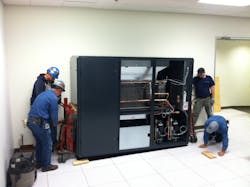No Room for Downtime: How to Win and Keep Mission Critical Service Agreements
When it comes to mission-critical facilities, such as hospitals, data centers, and laboratories, HVAC system uptime is essential. This offers an opportunity for HVAC contractors selling mission-critical service agreements. These agreements go beyond routine maintenance; they ensure uptime, reliability, and compliance for clients who simply can’t afford system failures. For contractors, knowing how to effectively position and sell these high-stakes agreements can be a game-changer. Contracting Business sat down with Greg Crumpton, vice president of Service Logic, a privately held HVAC and mechanical services company with 110 locations in the U.S. and Canada, providing commercial, industrial, and mission critical HVAC services, to discuss best practices for selling these types of agreements.
CB: What’s your typical sales pitch or value proposition for mission-critical clients?
GC: I rarely ever pitch to the Mission Critical operator. This is a customer that knows what they need, my job is to listen to that need, ensure I can help them with the proper skilled technicians, and be there when they need it. This is a very relational sale. People lose their jobs when they hire the wrong maintenance partner … being a known entity, staying sharp and cognizant of what clients are up against, and then helping them solve for that equation. That’s where I spend time when I am in a sales role.
CB: What specific services do you include in a service agreement for mission-critical environments?
GC: The needs vary widely based on the equipment that is part of the agreement. From Centrifugal Chillers using typical oiled bearing compressors to magnetic bearing (oil-free) chillers to adiabatic cooling systems on the airside, it is a wide breadth. Normally, you want to sit with the end-user and go through the scope of work, especially when there is an RFP that is put out to the market. Many times, what has been requested in an RFP can really be enhanced by a skilled partner. Maybe changing the frequencies of visits due to geographies, maybe knowing there is a Service Bulletin out on a specific piece of equipment that can modify the scope, or perhaps, working with the end-user to allow some of the lesser skill-required tasking to be done by her or his in-house team. There are times the RFP can be a cookie-cutter version and not site-specific, so if you have the chance, use the opportunity to really customize, through your optional services on your proposal, to stand out from the chaff.
CB: How do you differentiate your service agreements from competitors when pitching to a high-stakes client?
GC: The crux of it is making each opportunity your chance to shine. Do you understand what your client is trying to achieve? You may be thinking: “OK, it’s a data center.” So, I may be thinking super-high density facility, when maybe it is just a DR (disaster recovery) site and 3 kW per rack is and always will be the load. Perhaps the need is to maintain the space until the current lease expires, and they just need a “get by” plan. What matters is that you get close with the customer — they need an advisor, not just someone looking for a purchase order.
CB: What response time guarantees do you build into these contracts, and how do you support them operationally?
GC: Many times, there will be an SLA (service level agreement) for all parties for a two-hour, on-site response for an emergency situation. Some go beyond and have an hour timetable for a verbal communication to ensure the two-hour window will be upheld. You must remember, if a mission-critical facility is calling, they need help, they are not calling at 3:12 a.m. to say, “Hello.”
CB: How do you quantify the ROI or risk reduction of your service plans to decision-makers?
GC: The easy math is on downtime. Most truly “mission-critical” facilities know what it costs them when they are down, slowed, or partially down. Think of an MRI or CT Scan facility that cannot scan patients due to the chiller serving the magnet not being on-line - That is a costly venture. If you have a proven track record, the skilled and trained staff to accomplish the work, and actually perform the preventive service when scheduled and required, selling the agreement is not a difficult task. But you have to be knowledgeable, professional, up to speed on their needs, and understand what “Yes” and “Now” actually mean.
CB: Do you use performance metrics, uptime percentages, or cost avoidance models in your sales conversations?
GC: Depending on the ability of the digital controls package on the site, you can extrapolate a lot of data to help with your “proof that you are delivering,” otherwise you are using your ERP system to show the number of service calls, the Preventive Maintenance schedule, the findings, and the actions stemming from the maintenance visit. Sometimes, the contractor can do everything properly, propose a solution, and then it can sit there, on the end-users desk, not approved, then a failure occurs anchored in the discrepancy that you noted and proposed a solution for — that typically can help ramp up the communications between you and your client, as that scenario shows that you have been on the ball. But, depending on the type of maintenance agreement, you can be at the mercy of an approver. Other types of contracts, such as a “Full Service” or “Guaranteed Plan,” can allow the contractor the privilege of making the repairs upon finding them as the contract can be written to allow for pricing that will cover many items and tasks that are likely to be required over the life of the agreement.
CB: What objections do you most commonly hear, and how do you overcome them?
GC: Some of the objections can be about price — that’s then on the contractor to sit and go through the agreement line by line and show the hours that will be required. The industry maintenance programs flow around tasking — tasking is labor and material — if you want to perform the proper OEM-recommended maintenance program and tasking list, it is strictly a matter of labor and the material, but labor is the largest factor. Once you do that, if the customer thinks you are still too expensive, offer to cut the tasking to their budget level, but ensure (s)he knows what is being reduced in the scope. If two or three true professionals are proposing scope of work that is tight, on an accurate equipment list, there should not be a huge difference in cost, the difference is in the selling price.
CB: How do you maintain relationships with these clients after the sale to ensure retention and renewals?
GC: As mentioned earlier, the relationships with your mission-critical customers are very important. These folks live and die by the sword. If you have a Commercial Real Estate building and it gets hot, that is not a good scenario, but typically, people do not get fired for it. When dealing with mission-critical, it can literally be a life and death situation you are assisting with. You have to have people around you — both as the customer and as the contractor — that you trust. You may have to make decisions on the fly, having someone look at you and say, “Yes. Do it. Buy it. Order it. Air freight it in, or whatever the need is,” and you know their word will be backed up by a work order or purchase order at daylight is key. That is a true trusting relationship, and that is what it takes on both sides.
CB: Anything else you would like to add?
GC: I would emphasize that it isn’t for the faint of heart. If you are truly going to immerse yourself in this market, you must go all-in. A building with 50 or 100 Roof Top Units on it serving a warehouse, distribution space, call center or a similar facility is one thing, and nothing wrong with those buildings; however, the commitment to serve that facility versus a hospital surgical suite or an AI-heavy data center, or an operations center for a three-letter government agency is a totally different deal.
It is a lifestyle, not a job.
About the Author

Nicole Krawcke
Nicole Krawcke is the Editor-in-Chief of Contracting Business magazine. With over 10 years of B2B media experience across HVAC, plumbing, and mechanical markets, she has expertise in content creation, digital strategies, and project management. Nicole has more than 15 years of writing and editing experience and holds a bachelor’s degree in Journalism from Michigan State University.





